Establishment and Application of Crowd-Sensing-Based System for Bridge Structural Crack Detection
Abstract
1. Introduction
2. Crowd-Sensing-Based Crack Detection Method
3. Development of the Crowd Sensing Crack Collection System
3.1. Cloud Server Configuration
3.1.1. Cloud Platform Selection
3.1.2. Server Hardware and Software Configuration
3.2. Development of Cloud Management Platform
3.2.1. Function Design
3.2.2. Interface Design
3.3. Mobile App Development
3.3.1. Function Design
3.3.2. Page Design
4. Crack Detection Test
5. Conclusions
- (i)
- The crowd-sensing-based system for bridge structural crack detection was consisted of the cloud-based management platform and the mobile-based APP for crack information collection. The cloud platform was designed to conduct user management, crack information management and record query tasks. Meanwhile, the mobile-based APP could capture the crack images, location information and allow for short description. The location accuracy was around 5~10 m, and the crack description function can be used to provide assistance for crack location.
- (ii)
- The preliminary tests showed that the system could realize the intended crack information acquisition purposes. However, since these images were not obtained by trained engineers with uniform equipment, the quality, picturing condition and angles, and the resolution of the crack images varied.
- (iii)
- The crack detection results based on the deep neural network and the smartphone-based images showed that the deep neural network could detect most of the crack regions on these images when the background was clear and bright. Meanwhile, when the background was less contrast and complex, noise motifs could cheat the deep neural network.
Author Contributions
Funding
Institutional Review Board Statement
Informed Consent Statement
Data Availability Statement
Conflicts of Interest
References
- Cho, S.; Yun, C.B.; Sim, S.H. Displacement estimation of bridge structures using data fusion of acceleration and strain measurement incorporating finite element model. Smart Struct. Syst. 2015, 15, 645–663. [Google Scholar] [CrossRef]
- Dinh, K.; Gucunski, N.; Duong, T.H. An algorithm for automatic localization and detection of rebars from GPR data of concrete bridge decks. Autom. Constr. 2018, 89, 292–298. [Google Scholar] [CrossRef]
- Ni, Y.Q.; Ye, X.W.; Ko, J.M. Monitoring-Based Fatigue Reliability Assessment of Steel Bridges: Analytical Model and Application. J. Struct. Eng. 2010, 136, 1563–1573. [Google Scholar] [CrossRef]
- Ye, X.W.; Ni, Y.Q.; Wong, K.Y.; Ko, J.M. Statistical analysis of stress spectra for fatigue life assessment of steel bridges with structural health monitoring data. Eng. Struct. 2012, 45, 166–176. [Google Scholar] [CrossRef]
- Stephen, G.A.; Brownjohn, J.M.W.; Taylor, C.A. Measurements of static and dynamic displacement from visual monitoring of the Humber Bridge. Eng. Struct. 1993, 15, 197–208. [Google Scholar] [CrossRef]
- Ren, G.; Ding, R.; Li, H. Building an ontological knowledgebase for bridge maintenance. Adv. Eng. Softw. 2019, 130, 24–40. [Google Scholar] [CrossRef]
- Neves, L.A.C.; Frangopol, D.M.; Petcherdchoo, A. Probabilistic lifetime-oriented multiobjective optimization of bridge maintenance: Combination of maintenance types. J. Struct. Eng. 2006, 132, 1821–1834. [Google Scholar] [CrossRef]
- Frangopol, D.M.; Bocchini, P. Bridge network performance, maintenance and optimisation under uncertainty: Accomplishments and challenges. Struct. Infrastruct. E 2012, 8, 341–356. [Google Scholar] [CrossRef]
- Bocchini, P.; Frangopol, D.M. Connectivity-based optimal scheduling for maintenance of bridge networks. J. Eng. Mech. 2013, 139, 760–769. [Google Scholar] [CrossRef]
- Li, G.; He, S.H.; Ju, Y.F.; Du, K. Long-distance precision inspection method for bridge cracks with image processing. Autom. Constr. 2014, 41, 83–95. [Google Scholar] [CrossRef]
- Kong, X.X.; Li, J. Vision-based fatigue crack detection of steel structures using video feature tracking. Comput-Aided Civ. Inf. 2018, 33, 783–799. [Google Scholar] [CrossRef]
- Dietrich, J.I.; Inkala, M.A.; Männistö, V.J. Bridge inspection quality management. Transp. Res. Rec. 2005, 1933, 2–8. [Google Scholar] [CrossRef]
- Yeum, C.M.; Dyke, S.J. Vision-based automated crack detection for bridge inspection. Comput-Aided Civ. Inf. 2015, 30, 759–770. [Google Scholar] [CrossRef]
- Lins, R.G.; Givigi, S.N. Automatic crack detection and measurement based on image analysis. IEEE Trans. Instrum. Meas. 2016, 65, 583–590. [Google Scholar] [CrossRef]
- Abdel-Qader, I.; Abudayyeh, O.; Kelly, M.E. Analysis of edge-detection techniques for crack identification in bridges. J. Eng. 2003, 17, 255–263. [Google Scholar] [CrossRef]
- Zou, Q.; Zhang, Z.; Li, Q.Q.; Qi, X.B.; Wang, Q.; Wang, S. Deepcrack: Learning hierarchical convolutional features for crack detection. IEEE Trans. Instrum. Meas. 2018, 28, 1498–1512. [Google Scholar] [CrossRef] [PubMed]
- Yao, Y.; Tung, S.T.E.; Glisic, B. Crack detection and characterization techniques—An overview. Struct. Control. Health Monit. 2014, 21, 1387–1413. [Google Scholar] [CrossRef]
- Song, G.; Wang, C.; Wang, B. Structural health monitoring (SHM) of civil structures. Appl. Sci. 2017, 7, 789. [Google Scholar] [CrossRef]
- Feng, D.; Feng, M.Q. Computer vision for SHM of civil infrastructure: From dynamic response measurement to damage detection–A review. Eng. Struct. 2018, 156, 105–117. [Google Scholar] [CrossRef]
- Vrana, J.; Meyendorf, N.; Ida, N.; Singh, R. Introduction to NDE 4.0. In Handbook of Nondestructive Evaluation 4.0; Meyendorf, N., Ida, N., Singh, R., Vrana, J., Eds.; Springer: Cham, Switzerland, 2022. [Google Scholar]
- Duan, Y.F.; Chen, Q.Y.; Zhang, H.M.; Yun, C.B.; Wu, S.K.; Zhu, Q. CNN-based damage identification method of tied-arch bridge using spatial-spectral information. Smart Struct. Syst. 2019, 23, 507–520. [Google Scholar]
- Mangalathu, S.; Jeon, J.S. Ground motion-dependent rapid damage assessment of structures based on wavelet transform and image analysis techniques. J. Struct. Eng. 2020, 146, 04020230. [Google Scholar] [CrossRef]
- Guo, T.; Wu, L.P.; Wang, C.J.; Xu, Z.L. Damage detection in a novel deep-learning framework: A robust method for feature extraction. Struct. Control Health Monit. 2020, 19, 424–442. [Google Scholar] [CrossRef]
- Bubalo, M.; Zanten, B.T.V.; Verburg, P.H. Crowdsourcing geo-information on landscape perceptions and preferences: A review. Landsc. Urban Plan. 2019, 184, 101–111. [Google Scholar] [CrossRef]
- Elizabeth, A.S.; Zanten, B.T.V.; Davis, J.; Verburg, P.H. The advantage of mobile technologies in crowdsourcing landscape preferences: Testing a mobile app to inform planning decisions. Urban For. Urban Green. 2022, 73, 127610. [Google Scholar]
- See, L.; Mooney, P.; Foody, G.; Bastin, L.; Comber, A.; Estima, J.; Fritz, S.; Kerle, N.; Jiang, B.; Laakso, M.; et al. Crowdsourcing, citizen science or volunteered geographic information? The current state of crowdsourced geographic information. ISPRS Int. J. Geoinf. 2016, 5, 55. [Google Scholar] [CrossRef]
- Xing, Z.Y.; Zhang, X.D.; Zan, X.L.; Xiao, C.; Li, B.; Han, K.K.; Liu, Z.; Liu, J.M. Crowdsourced social media and mobile phone signaling data for disaster impact assessment: A case study of the 8.8 Jiuzhaigou earthquake. Int. J. Disaster Risk Reduct. 2021, 58, 102200. [Google Scholar] [CrossRef]
- Dunkel, A. Visualizing the perceived environment using crowdsourced photo geodata. Landsc. Urban Plan. 2015, 142, 173–186. [Google Scholar] [CrossRef]
- Matarazzo, T.J.; Santi, P.; Pakzad, S.N.; Carter, K.; Ratti, C.; Moaveni, B.; Osgood, C.; Jacob, N. Crowdsensing framework for monitoring bridge vibrations using moving smartphones. Proc. IEEE 2018, 106, 577–593. [Google Scholar] [CrossRef]
- Yang, J.X.; Xiang, F.Y.; Li, R.; Zhang, L.Y.; Yang, X.X.; Jiang, S.X.; Zhang, H.Y.; Wang, D.; Liu, X.L. Intelligent bridge management via big data knowledge engineering. Autom. Constr. 2022, 135, 104118. [Google Scholar] [CrossRef]
- Papadopoulou, C.A.; Giaoutzi, M. Crowdsourcing as a tool for knowledge acquisition in spatial planning. Future Internet 2014, 6, 109–125. [Google Scholar] [CrossRef]
- Matarazzo, T.; Vazifeh, M.; Pakzad, S.; Santi, P.; Ratti, C. Smartphone data streams for bridge health monitoring. Procedia Eng. 2017, 199, 966–971. [Google Scholar] [CrossRef]
- Mei, Q.; Gül, M.A. crowdsourcing-based methodology using smartphones for bridge health monitoring. Struct. Health Monit. 2019, 18, 1602–1619. [Google Scholar] [CrossRef]
- Figueiredo, E.; Moldovan, I.; Alves, P.; Rebelo, H.; Souza, L. Smartphone Application for Structural Health Monitoring of Bridges. Sensors 2022, 22, 8483. [Google Scholar] [CrossRef] [PubMed]
- Ozer, E.; Purasinghe, R.; Feng, M.Q. Multi-output modal identification of landmark suspension bridges with distributed smartphone data: Golden Gate Bridge. Struct. Control. Health Monit. 2020, 27, e2576. [Google Scholar] [CrossRef]
- Ozer, E.; Maria, Q.F. Community-Based Multi-Sensory Structural Health Monitoring System: A Smartphone Accelerometer and Camera Fusion Approach. IEEE Sens. J. 2021, 21, 20539–20551. [Google Scholar]
- Guzman-Acevedo, G.M.; Vazquez-Becerra, G.E.; Millan-Almaraz, J.R.; Rodriguez-Lozoya, H.E.; Reyes-Salazar, A.; Gaxiola-Camacho, J.R.; Martinez-Felix, C.A. GPS, accelerometer, and smartphone fused smart sensor for SHM on real-scale bridges. Adv. Civ. Eng. Mater. 2019, 2019, 6429430. [Google Scholar] [CrossRef]
- Alavi, A.H.; Buttlar, W.G. An overview of smartphone technology for citizen-centered, real-time and scalable civil infrastructure monitoring. Future Gener. Comput. Syst. 2019, 93, 651–672. [Google Scholar] [CrossRef]
- Ozer, E.; Feng, M.Q. Synthesizing spatiotemporally sparse smartphone sensor data for bridge modal identification. Smart Mater. Struct. 2016, 25, 085007. [Google Scholar] [CrossRef]
- Souza, V.M.A.; Giusti, R.; Batista, A.J.L. Asfault: A low-cost system to evaluate pavement conditions in real-time using smartphones and machine learning. Pervasive Mob. Comput. 2018, 51, 121–137. [Google Scholar] [CrossRef]
- Faggiani, A.; Gregori, E.; Lenzini, L.; Luconi, V.; Vecchio, A. Smartphone-based crowdsourcing for network monitoring: Opportunities, challenges, and a case study. IEEE Commun. Mag. 2014, 52, 106–113. [Google Scholar] [CrossRef]
- Ganti, R.K.; Ye, F.; Lei, H. Mobile crowdsensing: Current state and future challenges. IEEE Commun. Mag. 2011, 49, 32–39. [Google Scholar] [CrossRef]
- Li, X.; Goldberg, D.W. Toward a mobile crowdsensing system for road surface assessment. Comput. Environ. Urban Syst. 2018, 69, 51–62. [Google Scholar] [CrossRef]
- Aughey, R.J. Applications of GPS technologies to field sports. Int. J. Sports Physiol. Perform. 2011, 6, 295–310. [Google Scholar] [CrossRef] [PubMed]
- Shen, L.; Stopher, P.R. Review of GPS travel survey and GPS data-processing methods. Transp. Rev. 2014, 34, 316–334. [Google Scholar] [CrossRef]
- Yi, T.H.; Li, H.N.; Gu, M. Experimental assessment of high-rate GPS receivers for deformation monitoring of bridge. Measurement 2013, 46, 420–432. [Google Scholar] [CrossRef]
- Kaloop, M.R.; Li, H. Monitoring of bridge deformation using GPS technique. Ksce J. Civ. Eng. 2009, 13, 423–431. [Google Scholar] [CrossRef]
- Merry, K.; Bettinger, P. Smartphone GPS accuracy study in an urban environment. PLoS ONE 2019, 14, e0219890. [Google Scholar] [CrossRef]
- Zandbergen, P.A. Accuracy of iPhone Locations: A Comparison of Assisted GPS, WiFi and Cellular Positioning. Trans. GIS 2009, 13, 5–25. [Google Scholar] [CrossRef]
- Menard, T.; Miller, J.; Mowak, M.; Norris, D. Comparing the GPS capabilities of the Samsung Galaxy S, Motorola Droid X, and the Apple iPhone for vehicle tracking using FreeSim_Mobile. In Proceedings of the 14th International IEEE Conference of Intelligent Transportation Systems (ITSC), Washington, DC, USA, 5–7 October 2011. [Google Scholar]
- Garnett, R.; Stewart, R. Comparison of GPS units and mobile Apple GPS capabilities in an urban landscape. Cartogr. Geogr. Inf. Sci. 2015, 42, 1–8. [Google Scholar] [CrossRef]
- Yoon, D.; Kee, C.; Seo, J.; Park, B. Position Accuracy Improvement by Implementing the DGNSS-CP Algorithm in Smartphones. Sensors 2016, 16, 910. [Google Scholar] [CrossRef]
- Wen, Q.; Geng, J.H.; Li, G.C.; Guo, J. Precise point positioning with ambiguity resolution using an external survey-grade antenna enhanced dual-frequency android GNSS data. Measurement 2020, 157, 107634. [Google Scholar] [CrossRef]
- Fortunato, M.; Critchley-Marrows, J.; Siutkowska, M.; Ivanovici, M.L.; Benedetti, E.; Roberts, W. Enabling high accuracy dynamic applications in urban environments using PPP and RTK on android multi-frequency and multi-GNSS smartphones. In Proceedings of the 2019 European Navigation Conference, Warsaw, Poland, 9–12 April 2019; pp. 1–9. [Google Scholar]
- Tao, X.L.; Liu, W.K.; Wang, Y.Z.; Li, L.; Zhu, F.; Zhang, X.H. Smartphone RTK positioning with multi-frequency and multi-constellation raw observations: GPS L1/L5, Galileo E1/E5a, BDS B1I/B1C/B2a. J. Geod. 2023, 97, 43. [Google Scholar] [CrossRef]
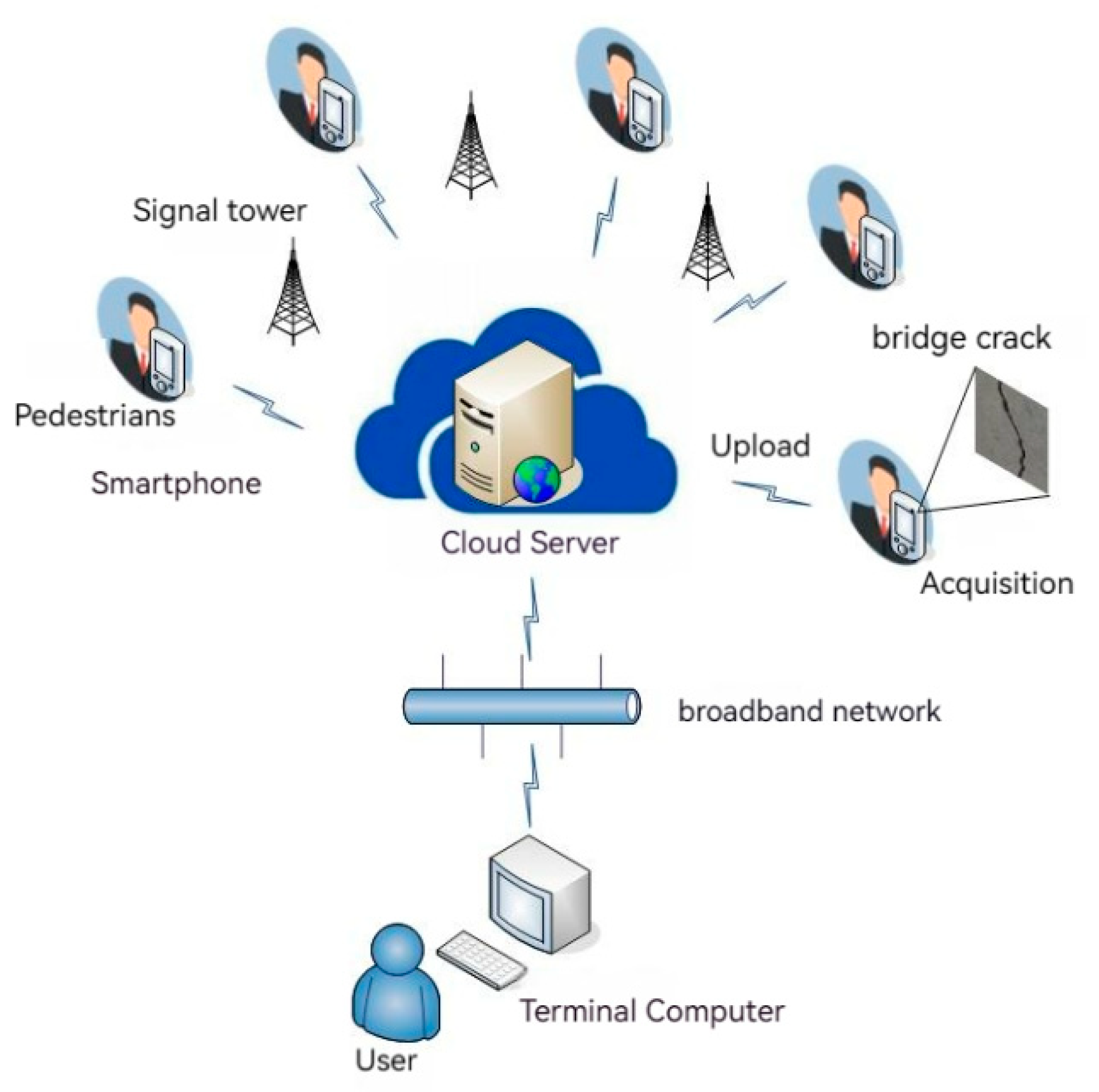
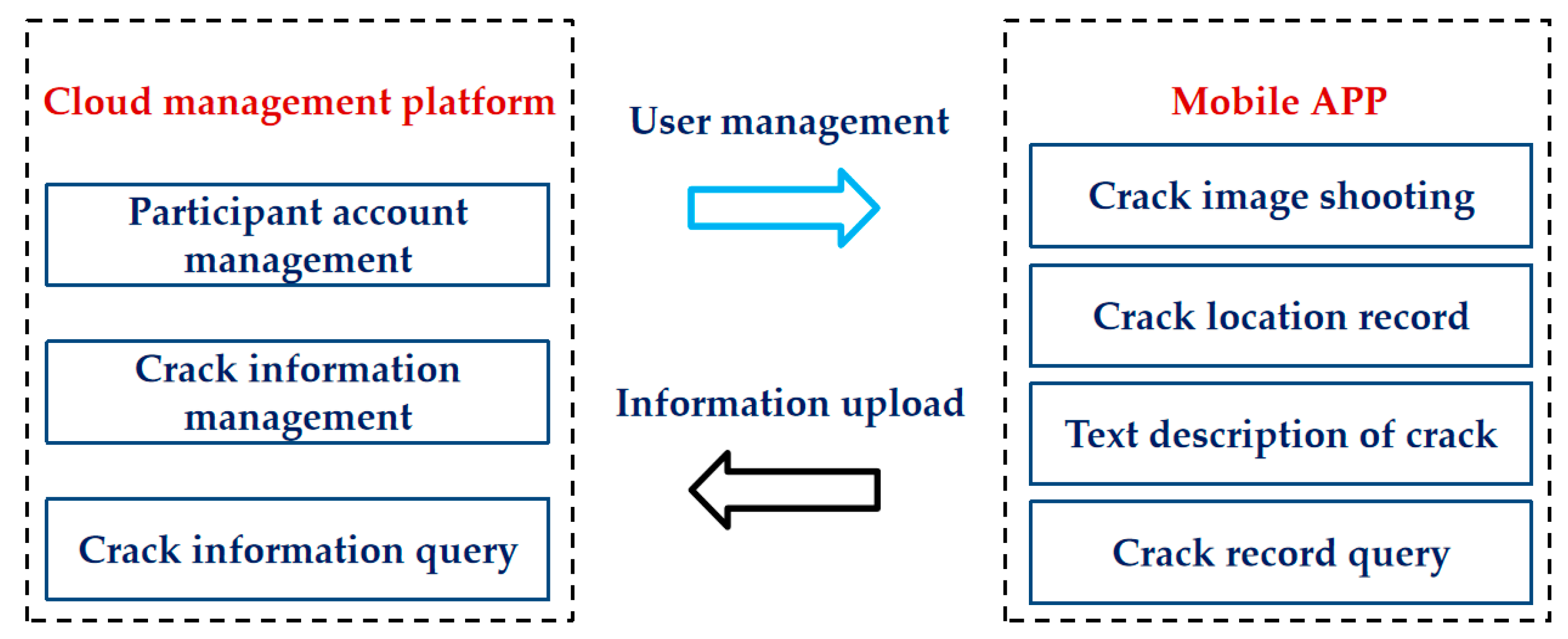
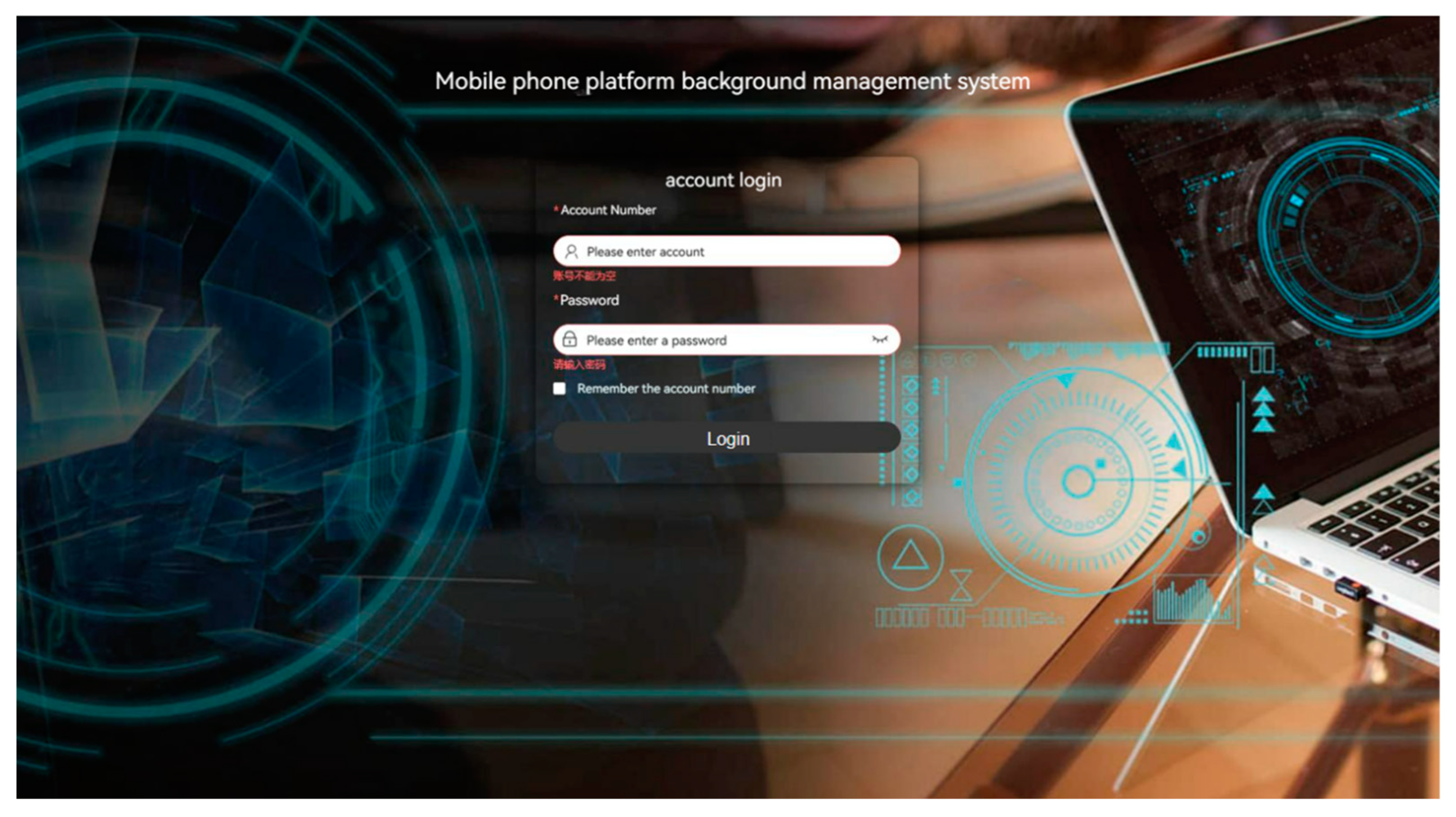
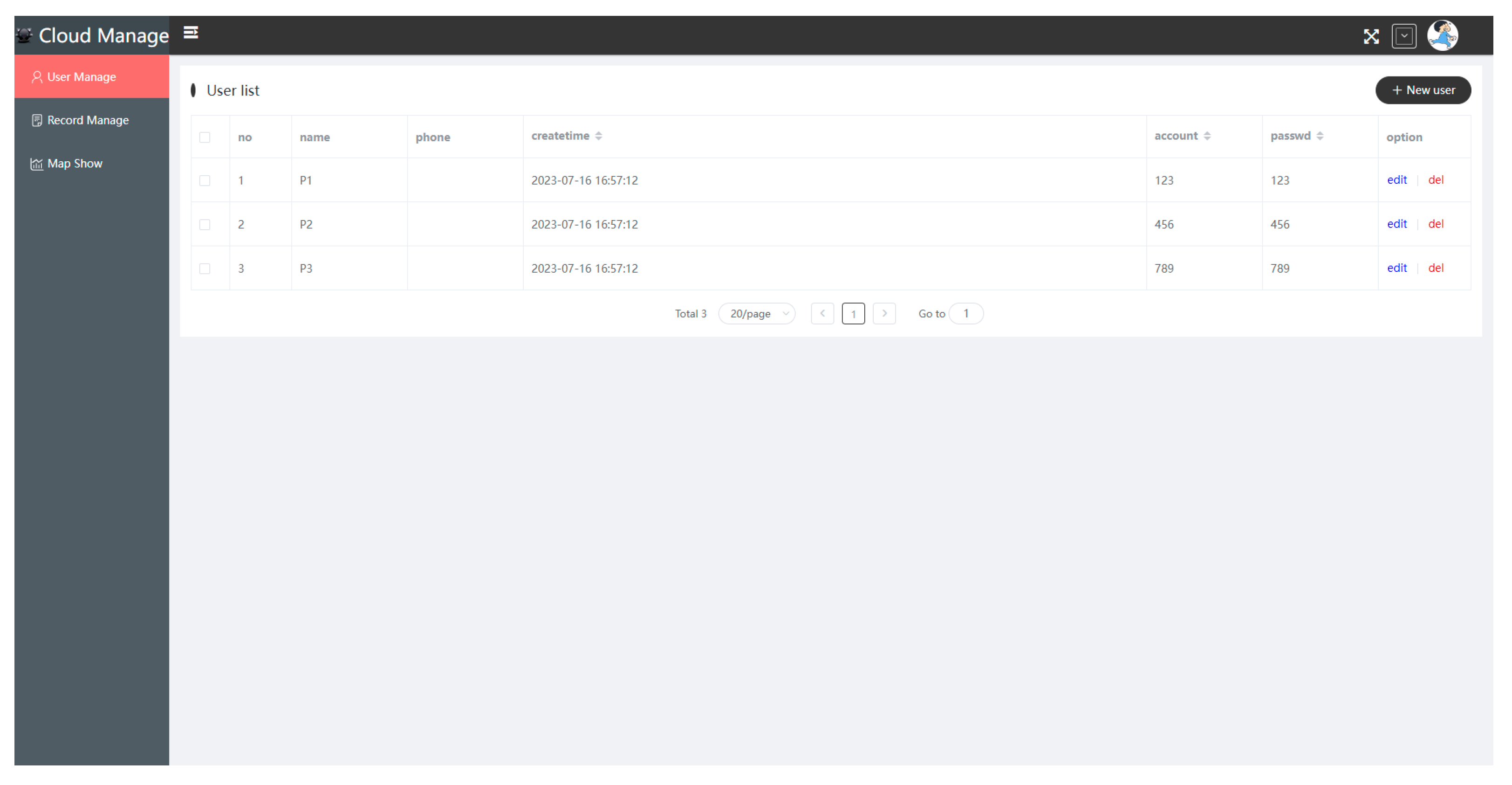
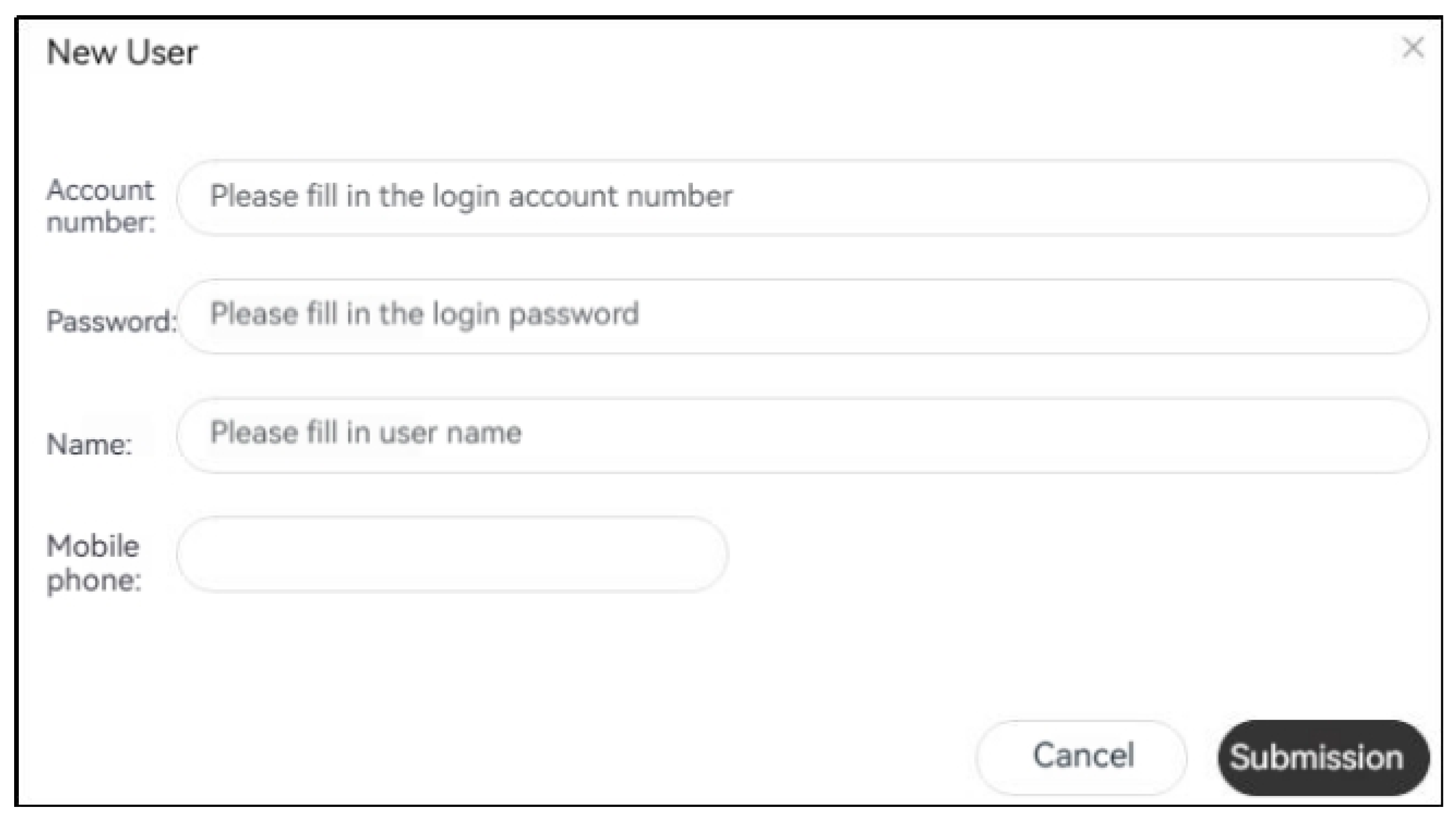
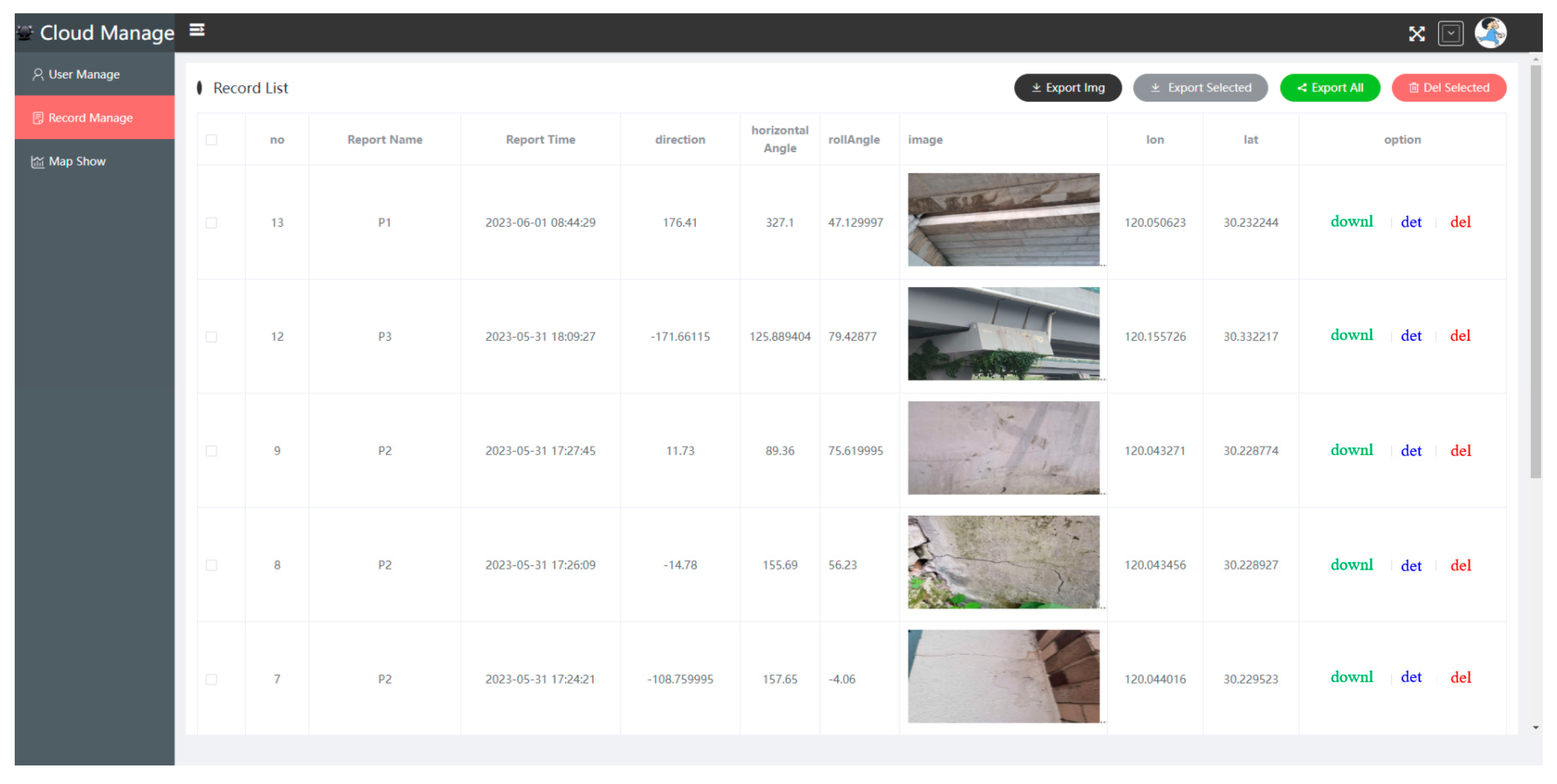

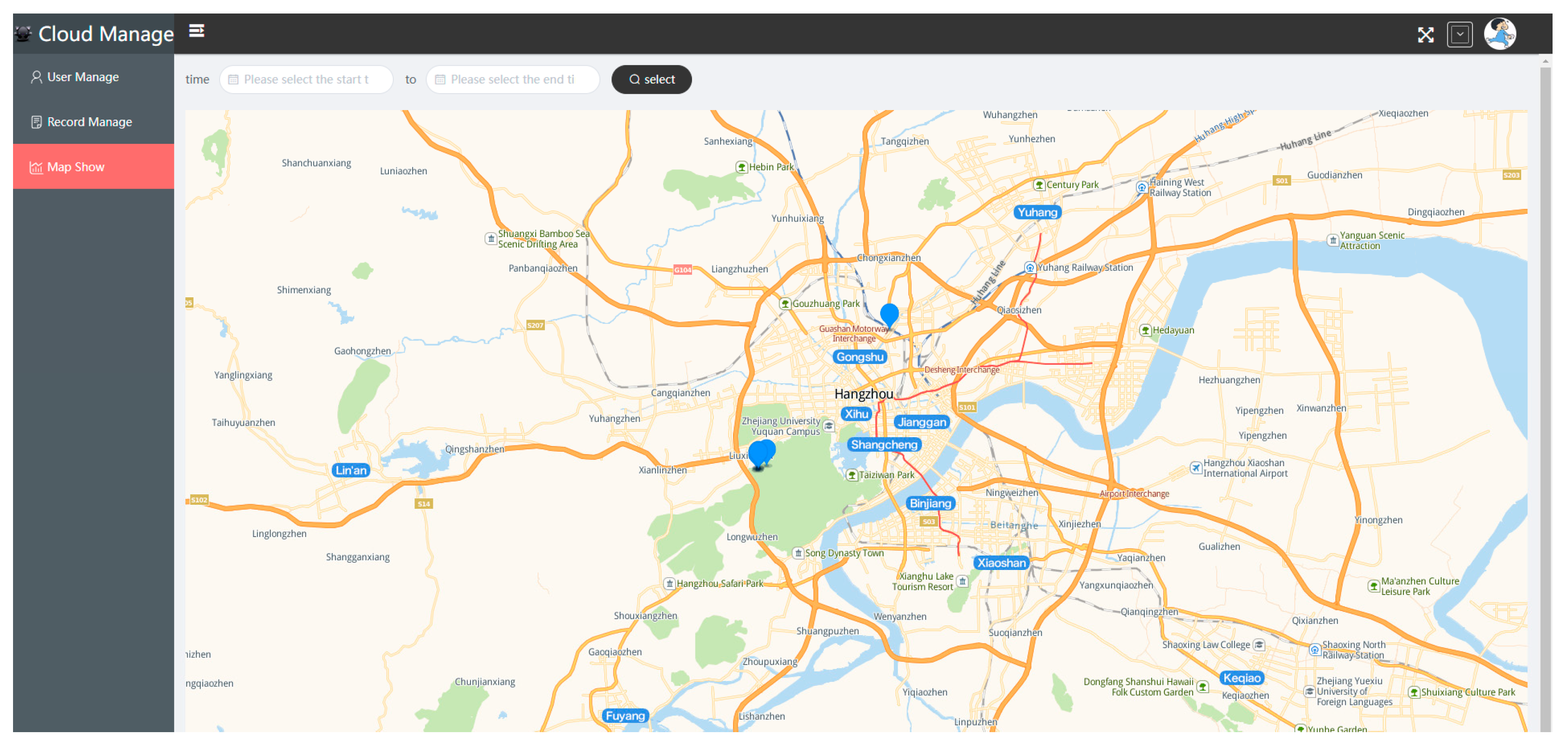
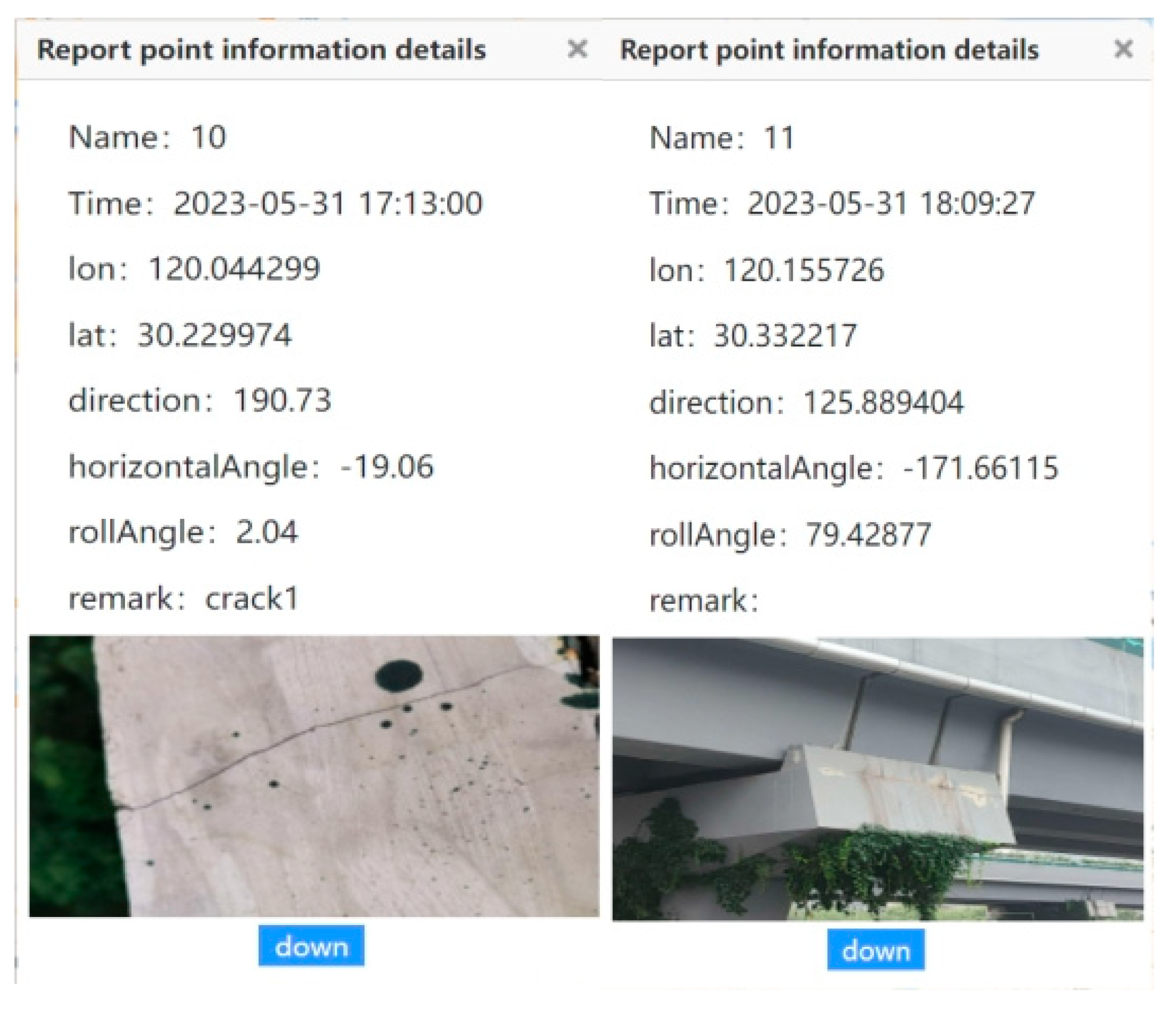


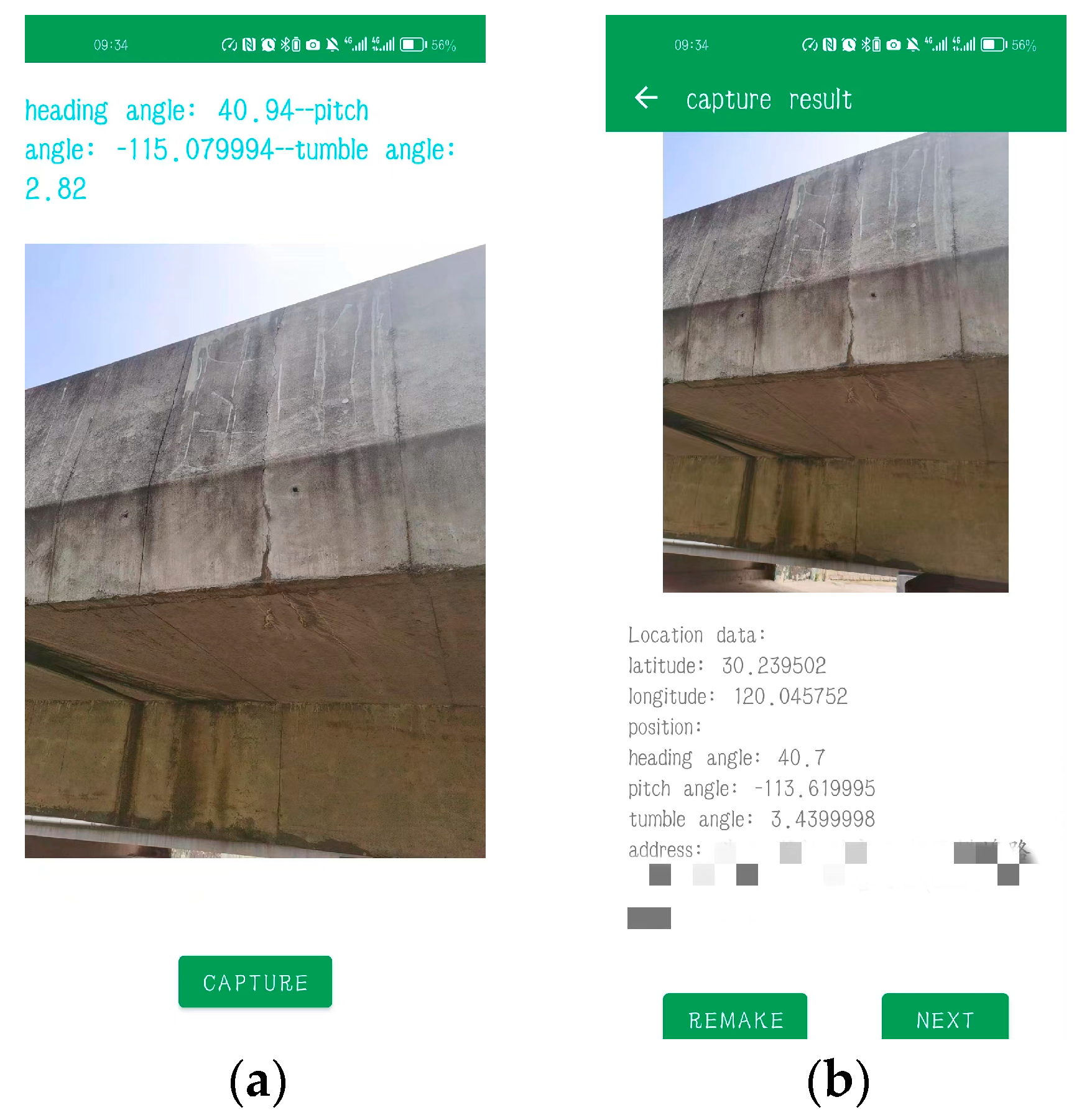


| Overall | Sub-Category | Version |
|---|---|---|
| Hardware | Memory | 2 G |
| Hard Drive | 40 G | |
| Bandwidth | 1 M/s | |
| Software | Operating system | Linux cent Os 7 |
| Database | MySQL 5.7 |
Disclaimer/Publisher’s Note: The statements, opinions and data contained in all publications are solely those of the individual author(s) and contributor(s) and not of MDPI and/or the editor(s). MDPI and/or the editor(s) disclaim responsibility for any injury to people or property resulting from any ideas, methods, instructions or products referred to in the content. |
© 2023 by the authors. Licensee MDPI, Basel, Switzerland. This article is an open access article distributed under the terms and conditions of the Creative Commons Attribution (CC BY) license (https://creativecommons.org/licenses/by/4.0/).
Share and Cite
Yuan, H.; Jin, T.; Ye, X. Establishment and Application of Crowd-Sensing-Based System for Bridge Structural Crack Detection. Appl. Sci. 2023, 13, 8281. https://doi.org/10.3390/app13148281
Yuan H, Jin T, Ye X. Establishment and Application of Crowd-Sensing-Based System for Bridge Structural Crack Detection. Applied Sciences. 2023; 13(14):8281. https://doi.org/10.3390/app13148281
Chicago/Turabian StyleYuan, Hangming, Tao Jin, and Xiaowei Ye. 2023. "Establishment and Application of Crowd-Sensing-Based System for Bridge Structural Crack Detection" Applied Sciences 13, no. 14: 8281. https://doi.org/10.3390/app13148281
APA StyleYuan, H., Jin, T., & Ye, X. (2023). Establishment and Application of Crowd-Sensing-Based System for Bridge Structural Crack Detection. Applied Sciences, 13(14), 8281. https://doi.org/10.3390/app13148281






